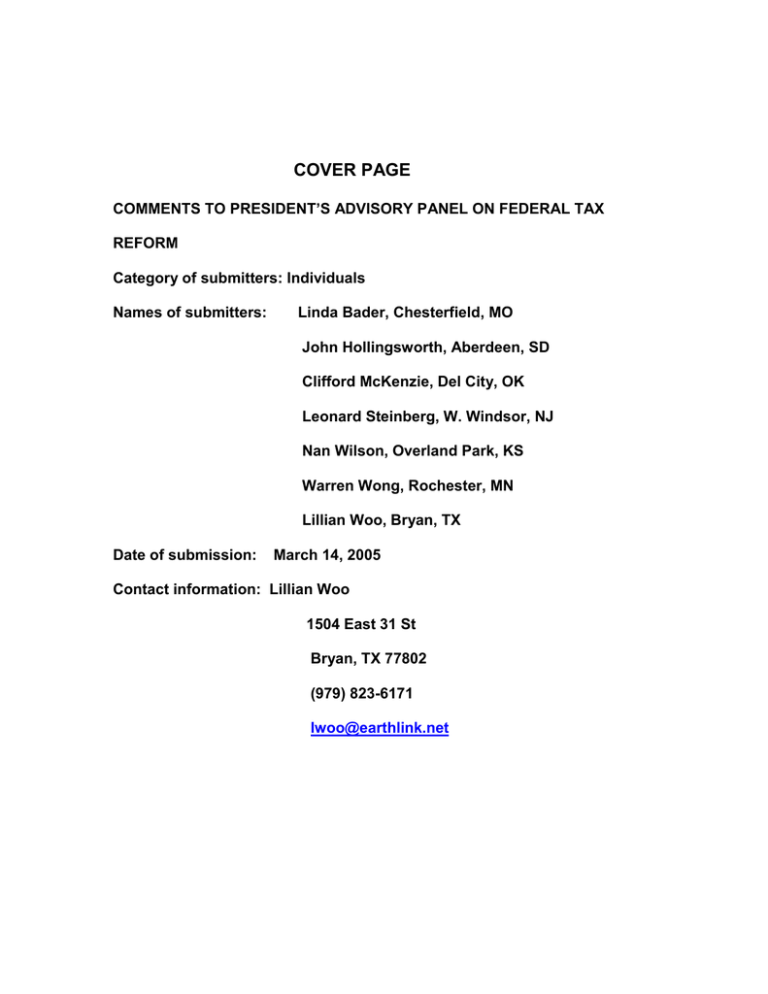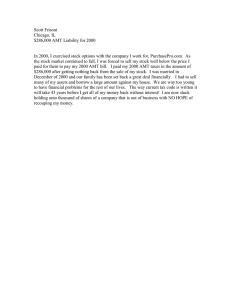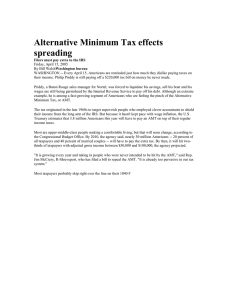COVER PAGE
advertisement

COVER PAGE COMMENTS TO PRESIDENT’S ADVISORY PANEL ON FEDERAL TAX REFORM Category of submitters: Individuals Names of submitters: Linda Bader, Chesterfield, MO John Hollingsworth, Aberdeen, SD Clifford McKenzie, Del City, OK Leonard Steinberg, W. Windsor, NJ Nan Wilson, Overland Park, KS Warren Wong, Rochester, MN Lillian Woo, Bryan, TX Date of submission: March 14, 2005 Contact information: Lillian Woo 1504 East 31 St Bryan, TX 77802 (979) 823-6171 lwoo@earthlink.net Lillian Woo Subject: Alternative Minimum Tax page 1 Who we are and why we are submitting comments. As seven present or former members of the 100 member Taxpayer Advocacy Panel, a federal advisory committee, we were appointed by the Secretary of the Treasury to recommend improvements in IRS service and to identify issues that are problematic for the taxpayer. In that capacity we focused on the projected exponential increase in the number of middle income taxpayers who will become liable for the Alternative Minimum Tax (AMT) within the next few years. In 2003 we forwarded through the National Taxpayer Advocate a recommendation to index the AMT for inflation. This proposal would eliminate millions of taxpayers who would otherwise be potentially affected by the AMT. In 2004, the IRS Forms and Publications Division asked us to review Form 6251, the worksheet that determines whether a taxpayer will have to pay AMT. We rewrote many sections of Form 6251 so that it would more clearly explain each section and be more easily understandable to the taxpayer. We forwarded our recommendations to Forms and Publications, and a good number of our proposals have already been adopted. This year, 2005, we are developing a plan to educate the taxpayer about the AMT and its projected rapid inclusion of middle income taxpayers if left unaltered. We are doing this because there is no official IRS publication on AMT in laymen’s language at present. Most of the IRS.gov documents on AMT are technical instructions on computing AMT and adjustments and tax preference items. Because we believe Lillian Woo page 2 that the impact of AMT in the next few years will dramatically increase the tax liability and burden on middle America., we have devoted several years to researching AMT. Before we begin our discussion of the inequitable burden of AMT, we want to clearly state the seven co-authors submit these comments as individual citizens and taxpayers and do not represent the Taxpayer Advocacy Panel. Statement. Since there is no shortage of published research, facts, figures, or projected revenue figures on AMT and its impending ambush of the unsuspecting middle income taxpayer, we will not restate known information about 1) AMT’s beginning, 2) its history of benign neglect that has led to its present condition, or 3) the projected phenomenal growth rate of AMT that will soon propel it past regular income tax as the major source of federal tax revenue. The Administration, Treasury, IRS, budget offices, US representatives and senators all know about this encroaching expansion of AMT to the middle class. As we talked with members of Congress about AMT, they all were sympathetic that middle income taxpayers will soon be swept into the jaws of the AMT. All felt it would be impossible to either index AMT for inflation or permanently raise the qualifying threshold. All said AMT generates much needed revenue to offset the budget deficit. All said they felt our pain, but their hands are tied. Given their limited courage and initiatives and their lack of support for their colleagues’ AMT reform bills, it is clear that only an independent tax reform panel, like President’s Advisory Panel on Federal Tax Reform, can achieve a wholesale change of Lillian Woo page 3 the tax structure and achieve a fair and simpler tax code that corrects the inequities, complexities, and burdens that have crept up on the average taxpayer over the years. Current flaws of AMT. The basic genetic flaw of the AMT is its Brownian effect on taxpayers in general. Any random combination or single item could plunge a taxpayer into AMT liability: 1) high state income tax; 2) high local property tax; 3) large number of dependent exemptions; 4) interest on home equity loans not used for home improvement: 5) exercise of stock options; 6) high capital gains or qualified dividends; 7) large miscellaneous itemized deductions; 8) large medical expenses. Even the tax cuts of this administration contribute to the expansion of the number of taxpayers who will pay AMT. By decreasing regular income tax liability without making any changes in AMT, the government has essentially added more taxpayers to the AMT rolls. Researchers agree that taxpayers who will pay AMT in 2005 include: 27% of taxpayers earning between $75-100,000; 54% between $100-200,000; and 83% between $200-500,000. It is estimated that by 2010 33-35 million taxpayers will pay AMT, up from 3 million in 2002. 33-35 million will account for roughly 1/3 of all individual taxpayers. Originally established to ensure that high income taxpayers pay some federal income tax, AMT has now become predominantly a tax on the middle class. Based on the trigger points mentioned above, the average taxpayer is walking into this higher tax liability trap with no knowledge or forewarning. Lillian Woo page 4 In our conversations with a large number of taxpayers in our respective states and regions about AMT, we seven co-authors found: 1) the average taxpayer’s lack of knowledge about AMT; 2) the inherent burden imposed on the individual taxpayer and the increased unfathomable complexity of AMT; and 3) horror stories of individual experiences with AMT. We concluded that this tax has become a Frankenstein’s monster on the loose. Burden. Burdens imposed by AMT on the taxpayer include losing their person exemptions for themselves and their dependents, losing their itemized deductions for state and local taxes, and losing their deductions for high medical bills. AMT penalizes marriage and families with children; The Urban-Brookings Tax Policy Center (Jan. 2004) estimated that couples will be twenty (20) times more likely than single taxpayers to pay AMT by 2010. In addition, by 2010 AMT will impose higher marginal tax rates than regular income tax for 93% of AMT taxpayers, and its effect will discourage savings, extra earnings, and investments that are currently favored under the regular tax. In addition, it may also encourage tax avoidance. AMT may redistribute the tax burden from mostly higher income taxpayers in 2000 to an increasing number of more middle income taxpayers in 2010. Studies estimate that the percentage of taxpayers affected by AMT with incomes between $5075,000 and four exemptions will increase from its year 2000 level of 1% to 32% in 2010. The primary cause of this astounding increase is that families in this income range will lose their personal exemptions and will have to add it back into their taxable income under AMT. Lillian Woo page 5 It is somewhat ironic that a taxpayer with an income of $35,000 qualifies for a tax refund under the Earned Income Tax Credit, but a taxpayer with an income between $5075,000 could be propelled into the higher AMT tax bracket. Complexity. The IRS and the National Taxpayer Advocate both have reported that the AMT is the most complicated and serious problem facing taxpayers. In addition, it would further complicate IRS’ efforts to administer and verify returns that include AMT. Horror for taxpayers. We would be happy to share our compilation of taxpayer nightmares with you, should you need them as examples of taxpayer hardship and anguish cause by AMT. Goals of panel re AMT. In your presidential charge to comprehensively simplify the tax code, you have the opportunity to modify the AMT and exempt middle income taxpayers from AMT. It can be achieved by indexing for inflation, allowing deductions for dependent exemptions, and by allowing personal credits, like state and local taxes, against AMT. This would decrease the number of AMT taxpayers by 88% by 2010, including over 98% of those who have incomes under $100,000. You also have the mandate to recommend changes to the entire tax structure so that the federal tax code is subject to regular indexing for growth in nominal incomes. As you know, nominal income takes into account not only inflation but also growth in real incomes. As representatives of a cross-section of the country with no vested interests in any particular section of the tax code, we seven co-authors share your goals of a simpler and fairer tax structure and would be pleased to assist your panel in any way that we can. -----Original Message----From: Lillian Woo [mailto:lwoo@earthlink.net] Sent: Monday, March 14, 2005 12:59 PM To: comments Subject: RE: Statement to Tax Panel about AMT Gentlemen: We appreciate the opportunity to submit public comments to your panel. Attached is our five page statement and a cover sheet. Sincerely, Lillian Woo, Bryan, TX Linda Bader, Chesterfield, MO John Hollingsworth, Aberdeen, SD Clifford McKenzie, Del Icty, OK Leonard Steinberg, W. Windsor, NJ Nan Wilson, Overland Park, KS Warren Wong, Rochester, MN

